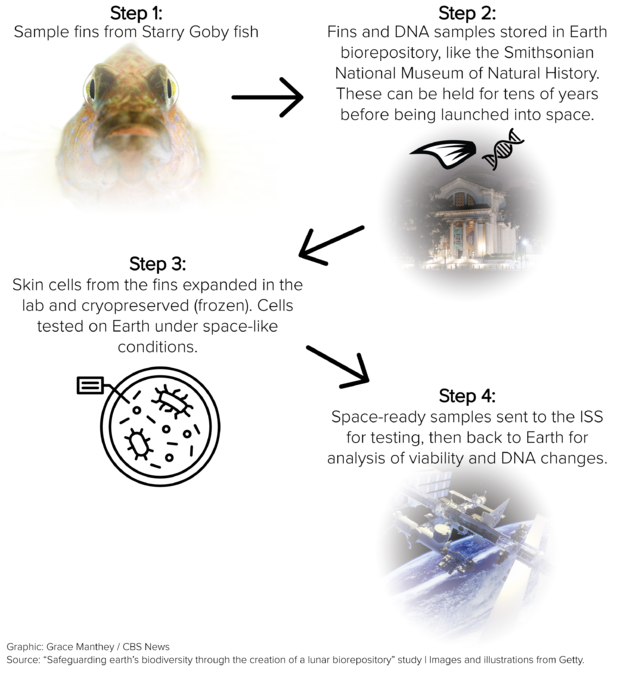plants and animals are die At a speed unprecedented on Earth. Some scientists are looking for solutions in outer space.
The idea, called a lunar biorepository, is a facility to maintain and store plant and animal cells. But it’s not on Earth, it’s on the Moon.
Why the moon?
“There’s no place on Earth that’s cold enough to do this,” explained Mary Hagedorn, a senior research scientist at the Smithsonian’s National Zoo and Institute for Conservation Biology.
Hagedorn has spent the past two decades researching and theorizing about modern approaches to trying to save coral reefs. She is an expert in cryopreservation, the process of freezing biological materials such as animal cells at extremely low temperatures, allowing them to remain frozen but still viable for hundreds of years.
“Let’s imagine that, unfortunately, climate change wipes out 90 percent of the Great Barrier Reef. Well, 100 years from now, we might be able to bring them back to all their diversity,” Hagedorn said.
She was inspired by Norway’s Arctic Seed Vault of Svalbard. permafrost. The low temperatures and humidity levels inside the vault allow the seeds to remain viable for a long time.
“Svalbard does a great job of saying, ‘Okay, we need to save seeds. Everything on Earth depends on seeds. How do we do that?'” Hagedorn said.
Hagedorn and her team hope to do something similar with animal cells, but they will need even lower temperatures. At the moon’s poles, where they are sheltered by deep craters, temperatures can reach as low as minus 320 degrees Fahrenheit or colder.
Preserving these animal skin cells, called fibroblasts, allows scientists to convert them into sex cells, which is how they clone animals in the lab.
In addition to threats and Endangered Animals Like African elephants, green sea turtles, and big cats, the Smithsonian Institution team proposes that the lunar biorepository would initially include a range of animal species with different uses, including:
- Those organisms that modify the environment, such as corals, beavers, woodpeckers, and earthworms.
- Pollinators that support food production, such as bees, moths, and bats.
- Animals that live in extremely hot, cold, or acidic environments, such as monarch butterflies, polar bears, and nematodes.
- Organisms that support Earth’s web of life, such as zooplankton, boreal trees and mosses.
Cryopreserved human heart stem cells were also recently sent to the International Space Station.
space challenge
As an experiment, the Smithsonian collected 10 samples of star gobies, a fish found in Kaneohe Bay, Hawaii. The vision is to seal these cells into cryogenic packaging and test them in space-like conditions on Earth, followed by test runs on the space station.
How the Smithsonian plans to create cryopreserved cells and test them in space:
Teams at the National Science Foundation’s National Ecological Observatory Network also collect nearly 100,000 animal cell samples from 81 sites each year. NEON aims to expand the types of cells used in cryopreservation to include sperm and oocytes from the ovary.
While a lunar biorepository may be a promising idea for protecting Earth’s biodiversity, the plan also faces challenges.
Researchers say one of the most difficult issues posed by a lunar biorepository is radiation exposure of samples. Radiation countermeasures may include antioxidant cocktails and providing physical barriers such as water, lead, or cement to block radiation.
Temperatures on the lunar surface that could lead to ice formation are also a concern.
Temperatures in some areas of the moon can reach over 200 degrees Fahrenheit during a lunar day, which is equivalent to about 14 days on Earth. Arctic and Antarctic craters have much colder temperatures, which could make transporting biological materials difficult.
Another challenge is that these areas, known as “permanently shadowed areas,” are believed to contain large amounts of ice, a situation that would make human monitoring extremely difficult.
The long-term effects of microgravity on cells can also be problematic.
Some say finding solutions on the moon should not be the first priority.
“I don’t think that’s the right idea right now,” said Noah Greenwald, endangered species director at the Center for Biological Diversity.
“I think we really need to focus on protecting more of the natural world so we don’t lose species in the first place,” he said.
Decades of effort
Hagedorn isn’t the only scientist working to create a biological repository on the moon.
In 2021, researchers at the University of Arizona proposed a concept An ark containing 335 million sperm and egg samples will be sent to the moon.
“They’re engineers,” Hagedorn pointed out. “So, we’re more of a biologist coming to the problem. We know how to cryopreserve. We start collecting samples. But they have a good understanding of how to use the robot.”
Hagedorn said that this is a decades-long effort and developing a lunar biorepository will require the cooperation of a range of countries, institutions, cultural groups and other stakeholders.
Greenwald said that while climate change is finally getting the attention it deserves, extinction crisis Right there.
“Species are the building blocks of ecosystems. They clean our air, they clean our water, they regulate our climate, they cycle nutrients. We should all be very concerned because the fact that we are losing species at such a rapid rate is true Reflecting the degradation of the ecosystems on which we ourselves depend,” Greenwald said.
#Endangered #species #extinct #Earth #saved #outer #space
Image Source : www.cbsnews.com
